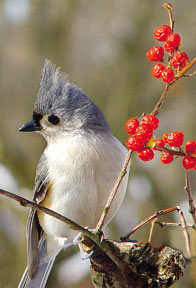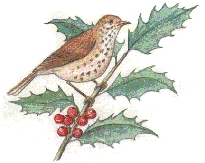 I hope everyone is enjoying the delight and peace of the holiday season. Keeping within the bountiful spirit of the season, please consider providing food, water and shelter for are feathery friends outside your home. As the temperatures start in on plunging lower for a longer period of time, December, January and February are most difficult months for birds to find food. Here are a few simple techniques of attracting and feeding birds in your backyard.
I hope everyone is enjoying the delight and peace of the holiday season. Keeping within the bountiful spirit of the season, please consider providing food, water and shelter for are feathery friends outside your home. As the temperatures start in on plunging lower for a longer period of time, December, January and February are most difficult months for birds to find food. Here are a few simple techniques of attracting and feeding birds in your backyard.
Bird watching is one of the most popular hobbies in the country, and is second only to gardening. That’s logical, because one can take part in both hobbies at the same time, in the same location. It’s enjoyable to give food to the birds, while learning to recognize the different species flocking to the backyard, as well as to study their individual habits. In able to watch birds, you must catch the attention of them first. Let’s for a moment discuss the three basic principles of providing water, food, and shelter.
 Birds really need our help in finding water during the winter months, especially if rains are not abundant. Provide a constant source of clean water for drinking and bathing. You can buy a bird bath, or supply a shallow pie tin, shallow kitchen bowl, or plant saucer. In addition to being a source for drinking, your container will serve as a bathtub as well! All birds need to maintain a ritual of preening their feathers, even in winter. Larger containers and bird baths make this possible. Water should not be more than an inch in depth, and it is helpful to provide a rock within the container that will serve as a perch for some of the smaller species. Just remember to replenish the water when needed. Containers holding water need to be kept clean. Adding a couple of tablespoons of household bleach to enough water to fill your container, and use a stiff brush to scrub off the residue. Rinse well before adding fresh water. Birds are attracted to the sound of dripping water; ponds and fountains serve as a natural magnet.
Birds really need our help in finding water during the winter months, especially if rains are not abundant. Provide a constant source of clean water for drinking and bathing. You can buy a bird bath, or supply a shallow pie tin, shallow kitchen bowl, or plant saucer. In addition to being a source for drinking, your container will serve as a bathtub as well! All birds need to maintain a ritual of preening their feathers, even in winter. Larger containers and bird baths make this possible. Water should not be more than an inch in depth, and it is helpful to provide a rock within the container that will serve as a perch for some of the smaller species. Just remember to replenish the water when needed. Containers holding water need to be kept clean. Adding a couple of tablespoons of household bleach to enough water to fill your container, and use a stiff brush to scrub off the residue. Rinse well before adding fresh water. Birds are attracted to the sound of dripping water; ponds and fountains serve as a natural magnet.
 Different species are attracted to different types of food. Some birds prefer seed, small nuts and berries; some eat insects, and some birds eat anything they can find. Cardinals, purple finches, chickadees and titmice love black oil sunflower seeds. Goldfinches prefer niger seed. Doves will eat millet. Carolina wrens are insect eaters and enjoy suet. Blue jays love peanuts, berries, fruit and insects. Mockingbirds eat insects, fruit, and can strip a chili pequin bush in no time! The Purple Martins that will migrate back to San Antonio during January-February strictly prefer insects. As a rule they do not come to feeders, but dine only while in flight. Instead of pruning back freeze-burned perennials, consider leaving the dried seed heads on the dead plants. They too, are a seed source.
Different species are attracted to different types of food. Some birds prefer seed, small nuts and berries; some eat insects, and some birds eat anything they can find. Cardinals, purple finches, chickadees and titmice love black oil sunflower seeds. Goldfinches prefer niger seed. Doves will eat millet. Carolina wrens are insect eaters and enjoy suet. Blue jays love peanuts, berries, fruit and insects. Mockingbirds eat insects, fruit, and can strip a chili pequin bush in no time! The Purple Martins that will migrate back to San Antonio during January-February strictly prefer insects. As a rule they do not come to feeders, but dine only while in flight. Instead of pruning back freeze-burned perennials, consider leaving the dried seed heads on the dead plants. They too, are a seed source.
Many of our birds love suet, and it serves as a substitute for insects in winter. Suet is nothing more than pure beef fat. Suet cakes are a great energy source in winter when insects are harder to find. Homemade suet cakes are an inexpensive, easy, and fun way to feed the birds in the winter. What you put in the suet cake is a matter of choice, as long as nothing is used that could be harmful to the birds. Try this simple recipe: Add to 3 cups of softened, white beef fat (absolutely NO meat), 1-1/2 cups each of peanut butter, corn meal and 3 to 4 cups of wild bird seed. Mix well and spoon into paper-lined muffin tins. When partially hardened, insert 6-inch loops of cord in the middle, by first poking a hole in the cake with an ice pick. Remove cakes and hang when thoroughly hardened, or store in the freezer until you are ready to use them.
Try stuffing the grooves of pine cones with peanut butter then rolling them in bird seed. Attach a looped string and hang the treats on tree branches. This is easy enough for a child to do. Save orange and grapefruit rinds that are cut in half. Using a heavy needle and thread, run the thread through the rind at three evenly spaced points around the edge, and make a hanger. Fill these natural fruit “cups” with peanuts, birdseed, apple wedges, raisins, dates and suet chunks.
One of the most popular seed types for a wide range of species is black oil sunflower seeds. A hanging tube feeder will provide easy access for the birds, while keeping the uneaten food clean and dry. Spilled seed will be eaten by ground-feeding birds. Try this idea for offering sunflower seed in its purest form: cut a small circle from the center of a dried sunflower head. Pass a 24-inch ribbon through the hole, and tie it from a tree branch. The birds will pull the seed from the flower. Place your treats outside a favorite window so you can watch the birds and observe their characteristic behaviors. Just be sure to place feeders far enough from your windows to give the birds turning room to avoid crashes as they fly off. Avoid placing outdoor furniture or planters in close proximity to the feeders. These items can serve as launching pads for cats. Other seeds commercially available are striped sunflower seeds, sunflower hearts (more expensive, but less messy), thistle or niger seed, millet, safflower, corn, and cracked corn. Keep in mind that different species will prefer different types of food.
Providing shelter of some sort will also make your backyard more attractive to birds. Shelter provides a safe haven from inclement weather and gives the birds a place to hide from predators such as cats, dogs, and man! Trees and dense shrubbery serve this purpose best, but large hanging planters, birdhouses, eaves and garages will be used by some species. Wrens and other ground feeding birds favor a pile of brush on top of a foundation of cut limbs.
If your landscape is in need of trees and shrubs, winter is a good time to research the berry-producing varieties available and record your notes and ideas. Some of our most common berry-producing shrubs are American beautyberry, rock cotoneaster, the hollies, the yaupons, nandina, ligustrum, photinia, Japanese yew, pyracantha, sumac, Barbados cherry, lantana and chili pequin. Should you desire to add berry-producing plants to your landscape, be sure to request female plants when shopping. Male plants do not produce berries.
Good information is available at the public library on bird watching, feeding, housing, and landscaping for birds (including plant selection lists). A winter garden full of feathered friends will bring colorful life to our currently dormant landscapes, along with the feeling that spring is just around the corner, so don’t forget to feed the birds.
Remember, Learn and Have Fun!
David Rodriguez is the County Extension Agent-Horticulture for Bexar County. He represents Texas Cooperative Extension with the Texas A&M University System.
For any landscape or gardening information, call the Bexar County Master Gardeners AHotline@ at (210) 467-6575, email questions to mg-bexar@tamu.edu, or visit our County Extension website at http:bexar-tx.tamu.edu/
Special Note: Listen “Live” with David Rodriguez every Saturday morning between
8:00-11:00 a.m. on WOAI 1200 AM, Gardening Show. Feel free to call in at 737-1200 or 1-800-383-9624.